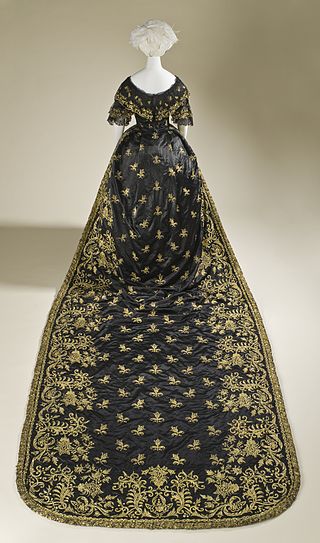
A cloak is a type of loose garment worn over clothing, mostly but not always as outerwear for outdoor wear, serving the same purpose as an overcoat, protecting the wearer from the weather. It may form part of a uniform. Cloaks have been and are worn in countless societies. Over time cloak designs have been changed to match fashion and available textiles.

A robe is a loose-fitting outer garment. Unlike garments described as capes or cloaks, robes usually have sleeves. The English word robe derives from Middle English robe ("garment"), borrowed from Old French robe, itself taken from the Frankish word *rouba, and is related to the word rob.

A coat typically is an outer garment for the upper body as worn by either gender for warmth or fashion. Coats typically have long sleeves and are open down the front and closing by means of buttons, zippers, hook-and-loop fasteners, toggles, a belt, or a combination of some of these. Other possible features include collars, shoulder straps and hoods.

Pall-mall, paille-maille, palle-maille, pell-mell, or palle-malle is a lawn game that was mostly played in the 16th and 17th centuries, a precursor to croquet.

Gabardine is a durable twill worsted wool, a tightly woven fabric originally waterproof and used to make suits, overcoats, trousers, uniforms, windbreakers, outerwear and other garments.

A petticoat or underskirt is an article of clothing, a type of undergarment worn under a skirt or a dress. Its precise meaning varies over centuries and between countries.

Frock has been used since Middle English as the name for an article of clothing, typically coat-like, for men and women.
Clothing terminology comprises the names of individual garments and classes of garments, as well as the specialized vocabularies of the trades that have designed, manufactured, marketed and sold clothing over hundreds of years.
Randle Cotgrave was an English lexicographer. In 1611 he compiled and published A Dictionarie of the French and English Tongues, a bilingual dictionary that represented a breakthrough at the time and remains historically important.

A pleat is a type of fold formed by doubling fabric back upon itself and securing it in place. It is commonly used in clothing and upholstery to gather a wide piece of fabric to a narrower circumference.

A shrug is a cropped, cardigan-like garment with short or long sleeves cut in one with the body, typically knitted. Generally, a shrug covers less of the body than a vest would, but it is more tailored than a shawl. Shrugs are typically worn as the outermost layer of an outfit, with a full shirt, tank top, or dress beneath.

In clothing, a train describes the long back portion of a robe, coat, cloak, skirt, overskirt, or dress that trails behind the wearer.

Moresque is an obsolete alternative term to "Moorish" in English, and in the arts has some specific meanings. By itself, the word is used to describe the stylized plant-based forms of tendrils and leaves found in ornament and decoration in the applied arts in Renaissance Europe that are derived from the arabesque patterns of Islamic ornament. Like their Islamic ancestors, they differ from the typical European plant scroll in being many-branched and spreading rather than forming a line in one direction. The use of half-leaves with their longest side running along the stem is typical for both.

A mantle is a type of loose garment usually worn over indoor clothing to serve the same purpose as an overcoat. Technically, the term describes a long, loose cape-like cloak worn from the 12th to the 16th century by both sexes, although by the 19th century, it was used to describe any loose-fitting, shaped outer garment similar to a cape. For example, the dolman, a 19th-century cape-like woman's garment with partial sleeves is often described as a mantle.
The Medieval period in England is usually classified as the time between the fall of the Roman Empire to the beginning of the Renaissance, roughly the years AD 410–1485. For various peoples living in England, the Anglo-Saxons, Anglo-Danes, Normans and Britons, clothing in the medieval era differed widely for men and women as well as for different classes in the social hierarchy. The general styles of Early medieval European dress were shared in England. In the later part of the period, men's clothing changed much more rapidly than women's styles. Clothes were very expensive and both the men and women of lower social classes continued also divided social classes by regulating the colors and styles these various ranks were permitted to wear. In the early Middle Ages, clothing was typically simple and, particularly in the case of lower-class peoples, served only basic utilitarian functions such as modesty and protection from the elements. As time went on the advent of more advanced textile techniques and increased international relations, clothing gradually got more and more intricate and elegant, even with those under the wealthy classes, up into the renaissance.

A caraco is a style of woman's jacket that was fashionable from the mid-18th to early 19th centuries. Caracos were thigh-length and opened in front, with tight three-quarter or long sleeves. Like gowns of the period, the back of the caraco could be fitted to the waist or could hang in pleats from the shoulder in the style of a sack back. Caracos were generally made of printed linen or cotton.

A jockey's cap is the headgear worn by a jockey in the sport of horse racing. The modern jockey's cap forms part of a jockey's "silks" or racing colours and is worn over a protective equestrian helmet.
Claudius Hollyband was a 16th-century French-English linguist, philologist, phonologist, lexicographer and instructor of English, French, Italian and Latin. He was the author of many books and treatises regarding language, including one of the earliest French-English dictionaries, A Dictionarie French and English, published in London in 1593.

An overskirt is a type of women's short skirt which is draped over another garment, such as a skirt, breeches, or trousers. Although peplum is often used as another term for overskirt, it should not be confused with the peplos or "peplum dress", which was worn in ancient Greece.

A partlet or partlett was a 16th century fashion accessory. The partlet was a sleeveless garment worn over the neck and shoulders, either worn over a dress or worn to fill in a low neckline.















